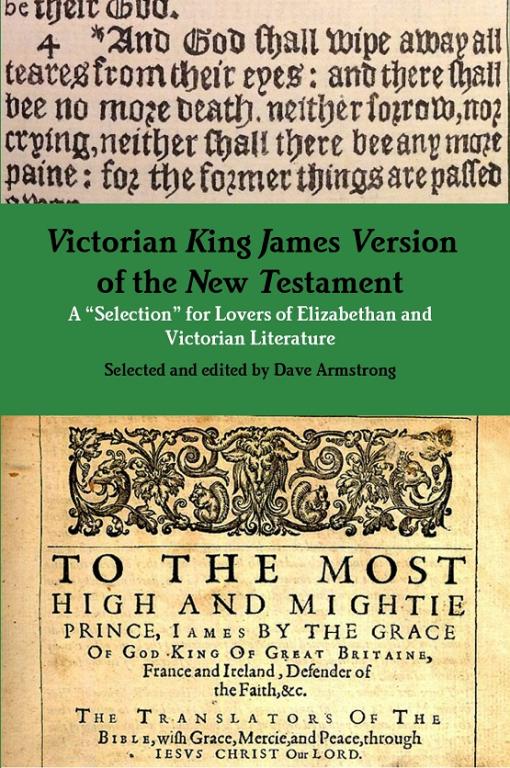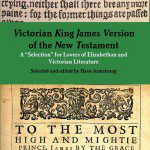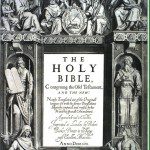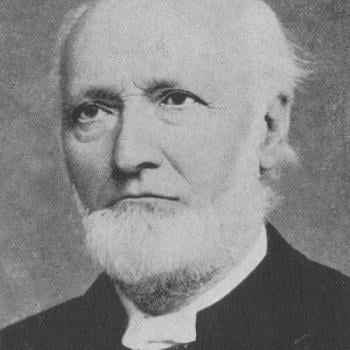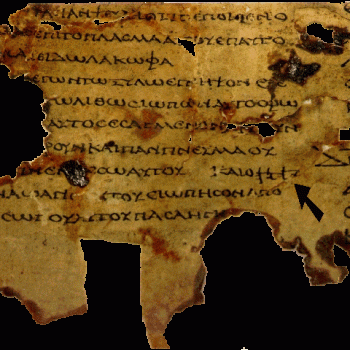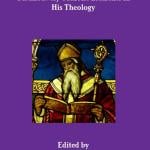Edited (“Selected”) by Dave Armstrong
[Lulu cover design by Dave Armstrong]
***
(11-15-13)
***
[this Introduction runs 12 pages in the book]
***
I’ve often thought about (as an outgrowth of my great love for the Bible) a “fresh” version that would retain the grandeur and majesty of the Authorized / “King James” Version’s 1611 English.
*
The general idea of removing archaisms has basically been done in well-known and widely used translations (I myself always use RSV in my study and my books) and many other lesser-known translations (all revisions of the King James Bible, or revisions of revisions: ASV to NASB / RV to RSV / KJV to NKJV, etc.). The present work is a similar “hybrid”.
*
I don’t know Greek, and am therefore not qualified in the slightest to actually translate. But I know English (as a professional author) and know the Bible (as a longtime Christian apologist) very well. This work, accordingly, isn’t technically a new translation at all, but rather a “selection” or collection of what I personally felt were the best renderings that maintained the KJV style as much as possible without the archaisms.
*
This can’t escape being my “subjective project” in that sense. I am the editor and determine the overall text, but (I can’t emphasize this highly enough) I’m not translator of even a single word. This New Testament is the product of a selection of wording from among the chosen renderings of those who are legitimate translators.
*
The main criticism or complaint will probably be that this work is presumptuous. It will be misunderstood by some, perhaps many, as to its vision and intent. I don’t think it is presumptuous at all, though, if someone merely selects from among the many existing translations (all done by linguists and scholars) and comes up with a new hybrid entity with the goal stated up front and made very clear: good English style and maintaining the KJV / Rheims Elizabethan “feel” while also emphasizing literalness of translation and understandability. I’m not claiming to be anything I am not; I’m just a lover of the Bible and good, classic, beautiful English writing.
*
I’m a great fan, specifically, of 18th and 19th century English prose (e.g., John Henry Newman, John Wesley, G. K. Chesterton: all authors I’ve massively read and from whom I’ve collected quotes for published “quotable” books). I also enjoy authors who continue this stylistic tradition, like C. S. Lewis, Ronald Knox, Thomas Howard, and others. That sense of style in prose (insofar as I have been influenced by it) is the leading motif or influence in my modifying or “updating” the KJV language and style (mostly whole verses and/or sentences; occasionally individual words or phrases).
*
If I were merely to update the KJV, it would be doing something scarcely different from what has been done a dozen times or more. But in highlighting the “Victorian” style of 18th-19th century British literature and Bible translations, the project thus acquires a uniqueness.
*
This is the selling point: updating the KJV with a 19th century high Victorian style that would have some strong sense of stylistic similarity (or analogous excellence, if you will) to Elizabethan English. It would be, in a word, a Bible for lovers of great English literature (both Elizabethan and Victorian): not for everyone, but for those who already have this interest, as I do.
*
The overall goal is “literal translation with [in revised passages] 19th century English style and flowing, readable quality.” Passages that remain magnificent today in the KJV or the Rheims 1582 New Testament need not be changed, as long as they are still able to be sufficiently understood. Other phrases or words strange or altogether unknown to us now, will be modified by choosing from other translations from the “Victorian” time period or shortly after it: all from Englishmen or (in two cases) Scotsmen. No American translations will be utilized.
*
There are plenty of translations available that fit the bill for what I’m looking for, that are in the public domain (no copyright issues or conflicts). I have arrived at five that I’ll be utilizing for alternate renderings (The Rheims New Testament provides an alternate “Elizabethan” translation in addition to the 1611 KJV):
*
1) Rheims New Testament (1582): the work principally of the Catholic priest Gregory Martin, with assistance from four other men.
*
2) Young’s Literal Translation (revised version of 1887) by Scotsman Robert Young: the same person who produced an elaborate Bible concordance (1879).
*
*
4) Twentieth Century New Testament (1904).
*
5) James Moffatt New Testament (1922): Moffatt was also a Scotsman.
*
My methodology, was to start with the KJV and Rheims New Testaments (the two “Elizabethan” ones), determine if one or the other was to be used, or else use another translation for passages that are archaic or different in meaning due to the evolution of English. Alternate renderings came from among the four additional scholarly translations above. By this method, only real, existing (and acclaimed) translations are utilized. Again; I didn’t “translate” a single word; I couldn’t, since I don’t know Greek. I also consulted the RSV and NASB versions as “models” in cases where it was difficult to choose which version to use.
*
I need to note a few elements of my editing, before I present a summary of the translations utilized:
*
1) Quotations from the Old Testament will be italicized (the method that Moffatt uses), will retain the older (KJV / Rheims) style, in order to convey a sense of citing ancient literature, and will be followed by the listing of the Old Testament passage cited (utilizing NASB cross-references).
*
2) No quotation marks will be used (KJV style). Quotations will start with a capital letter, following a comma.
*
3) The only changes to existing texts that I will make at all will be to capitalization (e.g., Weymouth uses capitalized divine pronouns; I will not, following the practice of most versions), or changing period to commas, etc., in order to make the text flow across verses.
*
4) Following the previous point, standardized proper names will be used, that are the most common (e.g., “Zebedee” rather than “Zebediah” or “Zabdi”: as some of the above versions render it). “Holy Spirit” will be used rather than “Holy Ghost.” I will change these in the text (but this can hardly be considered “translating” – since names often show variation).
*
5) The standard usage of “LORD” and “God” will be followed, rather than “Jehovah” or “Yahweh” or other alternate renderings.
*
The Authorized / King James Version of 1611 was translated by 47 men from the Church of England: all but one, clergymen, and most of the best biblical scholars in England. The text of the Bishops’ Bible (1572) was the primary guide for the translators, and (secondarily) other approved translations: the Tyndale Bible (1536), Coverdale Bible (1535), Great Bible (1539), and (especially, after the Bishop’s Bible), the Geneva Bible (1560).
*
In fact, the KJV Preface reveals that the translators regarded their work as a revision primarily of the Bishops’ Bible, rather than a fresh translation:
*
. . . we never thought from the beginning that we should need to make a new translation, nor yet to make a bad one a good one . . . but to make a good one better, or out of many good ones one principal good one, not justly to be excepted against; that hath been our endeavour, that our mark.
*
The New Testament portion was also stylistically influenced to a considerable extent by the Catholic Rheims New Testament, with the demonstrable adoption even of many of the former’s extensive and colorful “Latinate” words.
*
It was revised in a “Cambridge edition” in 1760: the culmination of twenty years of work by biblical scholar Francis Sawyer Parris (1707-1760), incorporating about about 24,000 changes: mostly outdated spelling and punctuation, and archaic language (as it was regarded at that time). Benjamin Blayney (1728-1801), slightly modified this 1760 version at Oxford in 1769: the result being the standard text ever since (excepting a few more changes).
*
The KJV’s profound influence on English language and literature is so well-known that it hardly needs to be mentioned. F. F. Bruce (1910-1990), the great biblical scholar, in his book, History of the Bible in English (Oxford University Press, 3rd edition, 1978, pp. 109-110), stated:
*
A study of its prose rhythms suggests that the men responsible for it (not only King James’s revisers but their predecessors as far back as Tyndale) had an instinctive feeling for good style. . . Prose rhythms do not obtrude themselves on the notice of readers or hearers, but they make a powerful impression none the less. Harsh combinations of sounds or accents, on the other hand, produce a sense of distaste.
*
The Rheims New Testament (1582), like all Catholic versions until the 20th century, was a translation of St. Jerome’s Latin Vulgate from the 5th century, though primary translator Gregory Martin “conferred” with Greek manuscripts as well, and his version shows particular awareness of subtle distinctions in the Greek past tense; moreover, Bruce noted (pp. 122-123) that its treatment of the Greek definite article was “more accurate” than that of the KJV. It also was influenced by the Protestant Tyndale translation and the earlier Wycliffe Bible.
*
It was greatly revised by Bishop Richard Challoner in 1750; drawing considerably from KJV style, as his “base text.” The result was a revised version – geared towards greater readability – that bore more similarity to the KJV than its own heavily “latinate” predecessor. Bruce describes a “profound influence . . . even more in the cadences of the language than in the vocabulary” (p. 125).
*
Young’s Literal Translation, produced by Scottish Bible scholar Robert Young (1822-1888), fully lives up to its name. It’s considered the most literal translation of the Bible available. The work was first published in 1862, but revised in 1887, in order to take into account the cutting-edge Westcott–Hort Greek text.
*
In the Preface to the second edition, the translator unequivocally states:
*
This inspiration extends only to the original text, as it came from the pens of the writers, not to any translations ever made by man, however aged, venerable, or good; and only in so far as any of these adhere to the original–neither adding to nor omitting from it one particle–are they of any real value, for, to the extent that they vary from the original, the doctrine of verbal inspiration is lost, so far as that version is concerned.
*
If a translation gives a present tense when the original gives a past, or a past when it has a present; a perfect for a future, or a future for a perfect; an a for a the, or a the for an a; an imperative for a subjunctive, or a subjunctive for an imperative; a verb for a noun, or a noun for a verb, it is clear that verbal inspiration is as much overlooked as if it had no existence. THE WORD OF GOD IS MADE VOID BY THE TRADITIONS OF MEN. [emphasis in original] . . .
*
The following translation need not, and ought not, to be considered, in any sense, as coming into competition with the Common Version, but as one to be used in connection with it, and as auxiliary to it; and not a few assurances have been received from clergymen and others that they thus use it, and find it at once interesting and profitable.
F. F. Bruce describes it as “designed to put the English reader as far as possible on a level with the reader of the Hebrew and Greek texts” (p. 132).
*
The Twentieth Century New Testament (1904) was done by twenty British translators who weren’t scholars in the field, but who knew koine Greek. These included wives of ministers, housewives, school teachers, telegraph engineers, and railroad workers. It’s considered the first “modern English” Bible. F. F. Bruce marvels at it:
*
How they succeeded in producing such an excellent version is difficult to understand. In later years several scholars have been glad to avail themselves of interpretations and renderings suggested by this non-specialist effort. (p. 154)
*
The aims of the translators are made very clear in the Preface:
*
This translation of the New Testament is an endeavour to do for the English nation what has been done already for the people of almost all other countries to enable Englishmen to read the most important part of their Bible in that form of their own language which they themselves use. It had its origin in the recognition of the fact that the English of the Authorized Version (closely followed in that of the Revised Version), though widely valued for its antique charm, is in many passages difficult, or even quite unintelligible to the modern reader. The retention, too, of a form of English no longer in common use is liable to give the impression that the contents of the Bible have little to do with the life of today. . . .
*
We believe that the New Testament will be better understood by modern readers if presented in a modern form; and that a translation of it, which presents the original in an exalted literary and antiquated dress, cannot, despite its aroma and the tender memories that have gathered around it, really make the New Testament for the reader of to-day the living reality that it was to its first readers. . . .
*
Our constant effort, . . . has been to exclude all words and phrases not used in current English.
*
By contrast, Baptist linguist and classical scholar Richard Francis Weymouth (1822-1902) was the lone translator of the Modern Speech New Testament (1903): usually known today by his name. F. F. Bruce gives his opinion of the work:
*
. . . the translator had no other object in view than the rendering of the New Testament into dignified modern English, with no theological or ecclesiastical bias . . .
*
His “modern speech” is not ultra-modern; he had no objection to using archaic words provided that they were still understood at the beginning of the twentieth century. “Without at least a tinge of antiquity, it is scarcely possible that there should be that dignity of style that befits the sacred themes.” . . .
*
It was a good omen that the first years of this century should see two such admirable versions of the New Testament in good twentieth-century English. (pp. 157, 160)
*
Linguist, exegete, and Church historian James Moffatt (1870-1944), a Scotsman from Glasgow, produced the final revision of his New Testament in 1922, for his New Translation of the entire Bible. He wrote in a 1926 Introduction to his work:
*
The aim I have endeavoured to keep before my mind in making this translation has been to present the books of the Old and the New Testament in effective, intelligible English. No translation of an ancient classic can be quite intelligible, it is true, unless the reader is sufficiently acquainted with its environment to understand some of its flying allusions and characteristic metaphors. But something may be done and, I am convinced, ought to be done at the present day to offer the unlearned a transcript of the Biblical literature as it lies in the light thrown upon it by modern research. The Bible is not always what it seems to those who read it in the great prose of the English version, or, indeed, in any of the conventional versions. What it is, may be partly suggested by a new rendering, such as the following pages present, that is, a fresh translation of the original, not a revision of any English version.
*
And four years earlier in a Preface to his New Testament, he stated:
*
Any new translation starts under a special handicap. It appears to challenge in every line the rhythm and diction of an English classic, and this irritates many who have no knowledge of the original. The old, they say, is better. . . . But intelligibility is more than associations, and to atone in part for the loss of associations I have endeavoured to make the New Testament, especially St. Paul’s epistles, as intelligible to a modern English reader as any version that is not a paraphrase can hope to make them.
*
F. F. Bruce is a great admirer of Moffatt’s version as well:
*
Moffatt’s translation is characterized by the freedom and vigour of his idiom . . . if a translator’s business is to produce on his readers the same effect as the original text produced on those who read and heard it, Moffatt succeeded wonderfully; and this is part of the secret of the popularity of his version. (pp. 167-168)
*
. . . to read through . . . a New Testament epistle in his version is one of the best ways to get a grasp of the general argument. And people who have been brought up to know and love the A.V. [KJV] from infancy should consider that much of it sounds foreign to those who have not been brought up to appreciate its wording. To such people Moffatt undoubtedly has made the Bible message intelligible . . . (p. 171)
*
Moffatt makes many highly interesting observations about translation in general, and his own. In his last Preface to his complete Bible, from December 1934, he wrote:
*
. . . any translator has a deep sense of responsibility. . . . He desires his transcript to be faithful to the meaning of the original, so far as he can reach that meaning, and also to do some justice to its literary qualities. But he is well aware that his aim often exceeds his grasp. Translation may be a fascinating task, yet no discipline is more humbling.
*
In the 39-page Introduction to the 1926 edition of the New Translation of the Bible, Moffatt continues his thought-provoking reflections:
*
To the best of my ability, I have tried to be exact and idiomatic. . . .
*
Gradually but steadily the English version of 1611 won the power and prestige of a classic. For one thing, it was literature, as none of its predecessors were, not even Tyndale nor the Douai version. “How real a creation,” says Newman [in The Idea of a University] how sui generis, is the style of Shakespeare, or of the Protestant Bible and Prayer Book, or of Swift, or of Pope, or of Gibbon, or of Johnson! Even were the subject-matter without meaning, though in truth the style cannot really be abstracted from the sense, still the style would, on that supposition, remain as perfect and original a work as Euclid’s elements or a symphony of Beethoven. And, like music, it has seized upon the public mind.” Yes, the style of the English version has been creative as well as a creation. It has entered into the literature and language of the English-speaking race. For once, a committee produced a classic. . . .
*
Let the version remain an English classic. But let us be certain about the truth of what it translates. There is a truth in beauty of style, but there is a beauty in truth, and whatever we may lose in parting with an English classic, we gain more by contact with the actual meaning of the original, of which this classic seems to be not quite a perfect representation. Besides, the Bible was originally written for common people in their own language. . . .
*
The archaisms of a masterpiece in Elizabethan prose had become either unintelligible or misleading. . . .
*
Finally, Moffatt (perhaps surprisingly for a non-Catholic scholar with a theologically liberal bent) acknowledges the high importance of the Latin Vulgate as a source in translation (which ties into the fact that the Rheims version – prominent in this present work – was a translation of the Vulgate):
*
. . . the Vulgate is important . . . as it was made before any of our extant manuscripts of the Greek New Testament, and made from materials that in some cases go back to the second century, perhaps even from some Greek manuscripts which no longer exist, it is indispensable as an aid to the task of ascertaining the original Greek text as that was read in North Africa at any rate during the second century. A translation will often show what the text of its original must have been, in a case of dispute. This Latin version of Jerome, then, along with the Syriac versions which go back to the third century at least, must be reckoned of first-rate importance.
*
In summary, the common thread throughout this Bible is my selection (as editor) – for individual verses – of either the KJV or Rheims or else alternate renderings from the other four versions of the New Testament listed and described above. The final product obviously reflects my taste in prose and style, but the (rather high and ambitious) goal is for it to be (hopefully) a New Testament characterized by a blending of the grandeur and majesty of both Elizabethan and Victorian prose.
*
I seek to put beauty and style in the forefront, while preserving literal translations. I aim to produce (as editor) a New Testament that accurately conveys the original language, and one that is theologically orthodox and beautiful: in the 19th century English high Victorian style, combined with unchanged beautiful, majestic Elizabethan style, in passages that are still able to be understood by today’s readers.
*
[Note: you can read the Gospel of Mark in a separate post, along with source analysis for chapters 1-4].
* * * * *


